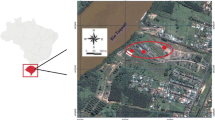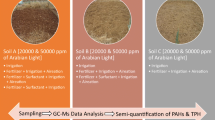Abstract
Purpose
This study predicts the optimal landfarming period for the total petroleum hydrocarbons (TPHs)-contaminated field soils that are subject to the combined landfarming and Fenton oxidation treatment.
Materials and methods
The TPHs degradation in the artificially contaminated model soils and the field-aged contaminated soils were compared in a laboratory scale. The soils were bioaugmented with the 16 petroleum hydrocarbon-degrading microbial cultures that are commercially available in Korea.
Results and discussion
The TPHs degradation by bioaugmentation in the model soils was 81 ± 2% after 56 days, while it was only 27 ± 2% after 74 days in the field-aged soils. The lower degradation in the field-aged soils can be attributed to the removal of a large part of the biodegradable and volatile TPHs fractions during the weathering process. The two-compartment model that can depict a fast-degradation phase followed by a slow-degradation phase predicted that the remedial goal of 475 mg kg−1 of TPHs could be achieved in the model soils within the conventional landfarming period of 60–120 days in Korea; however, the predicted period for the field-aged soils (710–4,086 days) was not practical requiring a combined biological and chemical treatment approach. Based on the kinetics study, the optimal landfarming period for the field-aged soils was 3 weeks and pre-Fenton oxidation can be used to meet the remedial goal.
Conclusions
The two-compartment model can be useful for predicting landfarming period for the combined landfarming and Fenton oxidation treatment of field-aged TPHs contaminated soils. The prediction of the optimal landfarming period could lead to the reduction in both the treatment cost and period.

Similar content being viewed by others
References
Adetutu E, Weber J, Aleer S, Dandie CE, Aburto-Medina A, Ball AS, Juhasz AL (2013) Assessing impediments to hydrocarbon biodegradation in weathered contaminated soils. J Hazard Mater. doi:10.1016/j.jhazmat.2013.1001.1052
Admon S, Green M, Avnimelech Y (2001) Biodegradation kinetics of hydrocarbons in soil during land treatment of oily sludge. Bioremed J 5:193–209
Alexander M (1999) Biodegradation and bioremediation, 2nd edn. Academic, San Diego
Atlas RM (1981) Microbial degradation of petroleum hydrocarbons: an environmental perspective. Microbiol Rev 45:180–209
Bento FM, Camargo FAO, Okeke BC, Frankenberger WT (2005) Comparative bioremediation of soils contaminated with diesel oil by natural attenuation, biostimulation and bioaugmentation. Bioresource Technol 96:1049–1055
Besalatpour A, Hajabbasi MA, Khoshgoftarmanesh AH, Dorostkar V (2011) Landfarming process effects on biochemical properties of petroleum-contaminated soils. Soil Sediment Contam 20:234–248
Brassington KJ, Hough RL, Paton GI, Semple KT, Risdon GC, Crossley J, Hay I, Askari K, Pollard SJT (2007) Weathered hydrocarbon wastes: a risk management primer. Crit Rev Env Sci Tec 37:199–232
Brusseau ML, Rao PSC (1991) Influence of sorbate structure on nonequilibrium sorption of organic compounds. Environ Sci Technol 25:1501–1506
Chaineau CH, Morel JL, Oudot J (1995) Microbial degradation in soil microcosms of fuel oil hydrocarbons from drilling cuttings. Environ Sci Technol 29:1615–1621
Cornelissen G, Rigterink H, Vrind BA, ten Hulscher DTEM, Ferdinandy MMA, van Noort PCM (1997) Two-stage desorption kinetics and in situ partitioning of hexachlorobenzene and dichlorobenzenes in a contaminated sediment. Chemosphere 35:2405–2416
Cuypers C, Clemens R, Grotenhuis T, Rulkens W (2001) Prediction of petroleum hydrocarbon bioavailability in contaminated soils and sediments. Soil Sediment Contam 10:459–482
Dandie CE, Weber J, Aleer S, Adetutu EM, Ball AS, Juhasz AL (2010) Assessment of five bioaccessibility assays for predicting the efficacy of petroleum hydrocarbon biodegradation in aged contaminated soils. Chemosphere 81:1061–1068
De Jonge H, Freijer JI, Verstraten JM, Westerveld J, Van Der Wielen FWM (1997) Relation between bioavailability and fuel oil hydrocarbon composition in contaminated soils. Environ Sci Technol 31:771–775
Dietzel KD, Campbell JL, Bartlett MG, Witten ML, Fisher JW (2005) Validation of a gas chromatography/mass spectrometry method for the quantification of aerosolized Jet Propellant 8. J Chromatogr, A 1093:11–20
El-Gendy NS, Farah JY (2011) Kinetic modeling and error analysis for decontamination of different petroleum hydrocarbon components in biostimulation of oily soil microcosm. Soil Sediment Contam 20:432–446
Goi A, Trapido M, Kulik N, Palmroth MRT, Tuhkanen T (2006) Ozonation and Fenton treatment for remediation of diesel fuel contaminated soil. Ozone: Sci Eng 28:37–46
Gong XB (2012) Remediation of weathered petroleum oil-contaminated soil using a combination of biostimulation and modified Fenton oxidation. Int Biodeter Biodegr 70:89–95
He Y, Xu J, Wang H, Wu Y (2007) Generalized models for prediction of pentachlorophenol dissipation dynamics in soils. Environ Pollut 147:343–349
Hejazi RF, Husain T, Khan FI (2003) Landfarming operation of oily sludge in arid region—human health risk assessment. J Hazard Mater 99:287–302
Hoff RZ (1993) Bioremediation: an overview of its development and use for oil spill cleanup. Mar Pollut Bull 26:476–481
Juwarkar AA, Singh SK, Mudhoo A (2010) A comprehensive overview of elements in bioremediation. Rev Environ Sc Biotechnol 9:215–288
Kaplan CW, Kitts CL (2004) Bacterial succession in a petroleum land treatment unit. Appl Environ Microbiol 70:1777–1786
Kaszycki P, Petryszak P, Pawlik M, Kołoczek H (2011) Ex situ bioremediation of soil polluted with oily waste: the use of specialized microbial consortia for process bioaugmentation. Ecol Chem Eng S 18:83–92
Kauppi S, Sinkkonen A, Romantschuk M (2011) Enhancing bioremediation of diesel-fuel-contaminated soil in a boreal climate: comparison of biostimulation and bioaugmentation. Int Biodeter Biodegr 65:359–368
Li G, Huang W, Lerner DN, Zhang X (2000) Enrichment of degrading microbes and bioremediation of petrochemical contaminants in polluted soil. Water Res 34:3845–3853
Lin TC, Pan PT, Cheng SS (2010) Ex situ bioremediation of oil-contaminated soil. J Hazard Mater 176:27–34
Lin TC, Pan PT, Young CC, Chang JS, Chang TC, Cheng SS (2011) Evaluation of the optimal strategy for ex situ bioremediation of diesel oil-contaminated soil. Environ Sci Pollut Res 18:1487–1496
Löser C, Seidel H, Hoffmann P, Zehnsdorf A (1999) Bioavailability of hydrocarbons during microbial remediation of a sandy soil. Appl Microbiol Biot 51:105–111
Maletić S, Dalmacija B, Rončević S, Agbaba J, Petrović O (2009) Degradation kinetics of an aged hydrocarbon-contaminated soil. Water Air Soil Poll 202:149–159
Margesin R, Zimmerbauer A, Schinner F (1999) Soil lipase activity—a useful indicator of oil biodegradation. Biotechnol Tech 13:859–863
Marin JA, Hernandez T, Garcia C (2005) Bioremediation of oil refinery sludge by landfarming in semiarid conditions: influence on soil microbial activity. Environ Res 98:185–195
Ministry of Environment (Korea) (2009) Official test method on soil pollution vol Ministry of Environment Notification No. 2009–255 (2009 October). Ministry of Environment (Korea), Seoul, Korea
Ministry of Environment (Korea) (2007) Guideline for contaminated soil remediation. Ministry of Environment (Korea), Seoul
Morgan P, Atlas RM (1989) Hydrocarbon degradation in soils and methods for soil biotreatment. Cr Rev Biotechn 8:305–333
Mrayyan B, Battikhi MN (2005) Biodegradation of total organic carbons (TOC) in Jordanian petroleum sludge. J Hazard Mater 120:127–134
Nam K, Rodriguez W, Kukor JJ (2001) Enhnaced degradation of polycyclic aromatic hydrocarbons by biodegradation combined with a modified Fenton reaction. Chemosphere 45:11–20
Palmroth MRT, Langwaldt JH, Aunola TA, Goi A, Puhakka JA, Tuhkanen TA (2006) Treatment of PAH-contaminated soil by combination of Fenton's reaction and biodegradation. J Chem Technol Biot 81:598–607
Reasoner DJ, Geldreich EE (1985) A new medium for the enumeration and subculture of bacteria from potable water. Appl Environ Microbiol 49:1–7
Silva-Castro GA, Rodelas B, Perucha C, Laguna J, González-López J, Calvo C (2013) Bioremediation of diesel-polluted soil using biostimulation as post-treatment after oxidation with Fenton-like reagents: assays in a pilot plant. Sci Total Environ 445–446:347–355
Srinivasarao Naik B, Mishra IM, Bhattacharya SD (2011) Biodegradation of total petroleum hydrocarbons from oily sludge. Bioremed J 15:140–147
Srivastava VJ, Kelley RL, Paterek JR, Hayes TD, Nelson GL, Golchin J (1994) A field-scale demonstration of a novel bioremediation process for MGP sites. Appl Biochem Biotech 45(46):741–756
Sugiura K, Ishihara M, Shimauchi T, Harayama S (1997) Physicochemical properties and biodegradability of crude oil. Environ Sci Technol 31:45–51
United States Environmental Protection Agency (USEPA) (1995) Method 3550B, Test method for extracting nonvolatile and semivolatile organic compounds from solid samples, SW-846. 3rd Edition, Revision 2 edn. U. S. Government Printing Office, Washington, DC
Valderrama C, Alessandri R, Aunola T, Cortina JL, Gamisans X, Tuhkanen T (2009) Oxidation by Fenton's reagent combined with biological treatment applied to a creosote-contaminated soil. J Hazard Mater 166:594–602
Verstraete W, Devliegher W (1996) Formation of non-bioavailable organic residues in soil: perspectives for site remediation. Biodegradation 7:471–485
Vincent AO, Felix E, Weltime MO, Ize-iyamu OK, Daniel EE (2011) Microbial degradation and its kinetics on crude oil polluted soil. Res J Chem Sci 1:8–14
Walling C, Johnson RA (1975) Fenton's reagent. V. hydroxylation and side-chain cleavage of aromatics. J Am Chem Soc 97:363–367
Ward O, Singh A, Van Hamme J (2003) Accelerated biodegradation of petroleum hydrocarbon waste. J Ind Microbiol Biot 30:260–270
Watanabe K (2001) Microorganisms relevant to bioremediation. Curr Opin Biotech 12:237–241
Xu J, Xin L, Huang T, Chang K (2011) Enhanced bioremediation of oil contaminated soil by graded modified Fenton oxidation. J Environ Sci 23:1873–1879
Acknowledgments
This study was financially supported by the Korean Ministry of Environment as the GAIA (Geo-Advanced Innovative Action) Project. The authors acknowledge the Ministry of National Defense for supplying the soil samples from the military bases in Korea and the Korea Environment Corporation and the hydrocarbon-degrading microbial cultures manufacturing companies for supplying the microbial cultures. The authors acknowledge the technical support by the Seoul National University Engineering Research Institute.
Author information
Authors and Affiliations
Corresponding author
Additional information
Responsible editor: Jizheng He
Rights and permissions
About this article
Cite this article
Jho, E.H., Ryu, H., Shin, D. et al. Prediction of landfarming period using degradation kinetics of petroleum hydrocarbons: test with artificially contaminated and field-aged soils and commercially available bacterial cultures. J Soils Sediments 14, 138–145 (2014). https://doi.org/10.1007/s11368-013-0786-z
Received:
Accepted:
Published:
Issue Date:
DOI: https://doi.org/10.1007/s11368-013-0786-z




